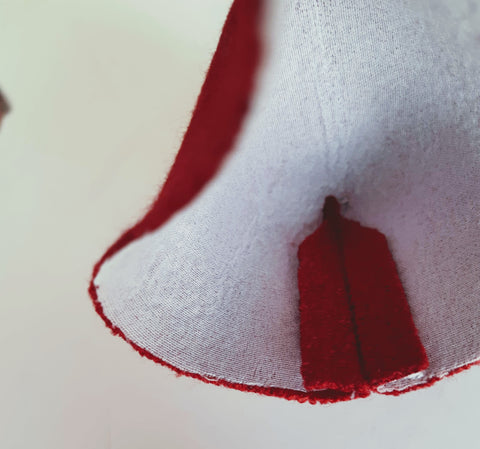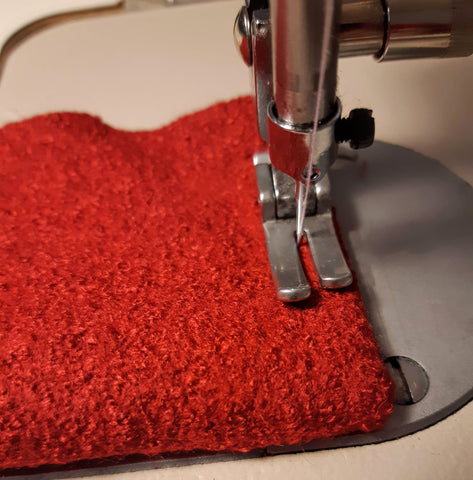Hi Everyone!
Before we talk about prep I'd like to take a minute and mention that I am going to try to use as much contrast fusing and thread as I can so you can actually see my steps. So, for the record, I don't recommend sewing red fabric with white thread but, in this case, it's just more effective in showing you what I'm talking about.
Here we go...
Now that your coat has been cut out, let's talk a little about prep prior to sewing. The first thing I'd like to talk about is interfacing. No matter what fabric you've chosen to work with I highly recommend interfacing the hems of your coat and sleeves. Interfacing will steady your hem, keeping it from stretching out and becoming "wavey" with everyday wear. Your choice of interfacing shouldn't be stiff. It can be rather soft and thin and it will still do its' job. As a matter of fact always choose thinner over thicker. You don't want your hems to look iron stiff.
I like to lay out my pieces, wrong side up and place my interfacing on top of the hems and just cut. You don't have to be perfect. So long as you cover the hem width which is 2" or 5cm. Below is a picture of my under sleeve hem interfaced.

Interface also, the back of your pocket flap...

And your welt...

Also interface the back, or wrong side, of your pocket panels where you'll sew your welt and flap pocket. To eliminate the guess work as to just how big your interfacing piece needs to be, use your welt pattern piece to cut out a second interfacing. It'll fit perfectly over your marked welt opening.

Now that your welt has been interfaced fold it at the notches, wrong sides together, and press.

You'll notice the welt is not folded equally in half. That't because this pattern piece has a welt and facing in one. The piece you are looking at now if the welt part that will be visible on outside of your coat.
This side of the welt (picture below) is the welt combined with the welt facing that will be on the inside of the pocket. You can go ahead and seam finish this side of the welt/welt facing with a zig zag stitch or overlock as shown. So why complicate things do a welt and welt facing all in one? I'm just reducing the bulk at the pocket. Less layers to sew through, therefore less bulk.

There are two more pieces to interface: the back neck facing and the front facing panel. The front facing is the full length of your coat and, because the way facings are shaped, they tend to waste A LOT of interfacing if you're to cut them side buy side.
So I'm going to talk about something I do to eliminate waste on large pattern pieces that require interfacing. This is not something you'll see in cut plans and layouts, something probably not discussed in sewing instructions. Maybe this advice will be even frowned upon but, I'm hoping, in the quite privacy of your sewing room when no one is looking, you do it too. What am I talking about? Cutting your interfacing in "block pieces" and assembling them together much like a puzzle!
Below is a picture of a front facing where I assembled my interfacing and ironed it on. You can see my overlap lines. This works on pretty much every fabric, with the exception of satin, where you will not see the overlapped interfacing show up on the right side of your pattern piece. On satin you'll have a distinct line where the interfacing overlaps.

Now Lets work on the pocket flap.
Fold your pocket flap at the notches, right sides together, and sew your pocket side seams with a 3/8"/1cm seam allowance. Trim your corner.

Press open the flap pocket's seams. Flip your pocket flap inside out and give it a press.


Top stitch your pocket flat. To get a nice top stitch increase the length of your stitch between 3-3.25 sometimes even 3.5 depending on the thickness of your fabric. A lengthened top stitch will show up a lot nicer on your pocket. I also like to use the edge of my presser foot as a width guide for my top stitching if you're doing a single row of topstitching.
If you'd prefer two rows of top stitch, sew your first row 1/8" from the pocket's edge. Using your presser foot as a guide, sew the second row.

Repeat the process for your second pocket flap and you are ready for next week when the pocket comes together! Until newt Wednesday...
Happy Sewing!
xo - J
